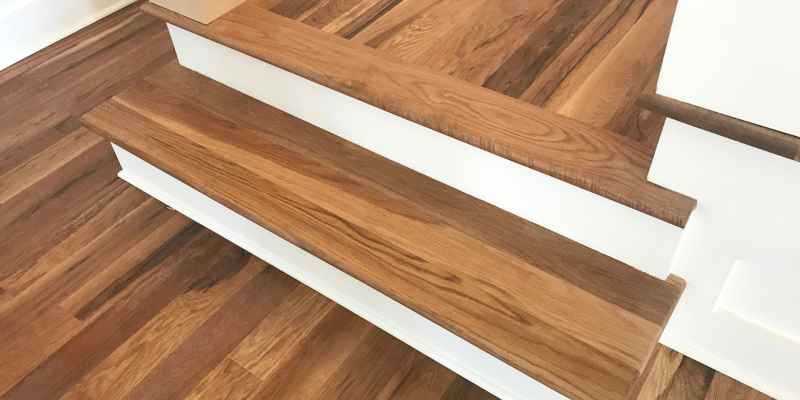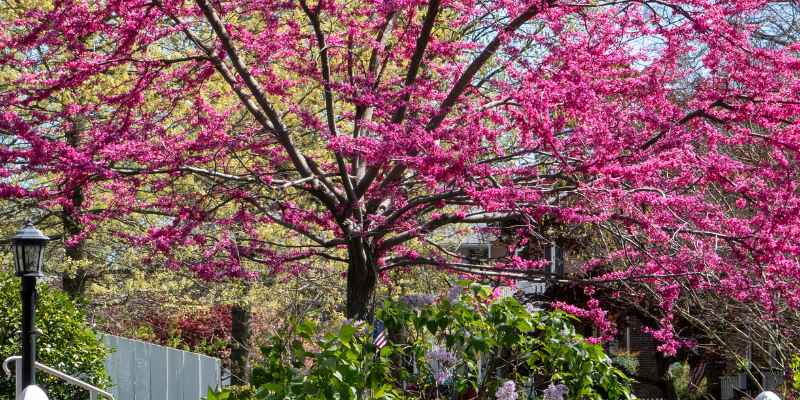Yes, a Redbud tree is considered a hardwood. Redbud trees belong to the hardwood category because their wood is dense and durable.
They are commonly used for making furniture, flooring, and other woodworking projects. The term “hardwood” refers to wood from deciduous trees, which are known for their broad leaves and produce seeds enclosed in a fruit or nut. Redbud trees are known for their vibrant pink or purple flowers that bloom in the spring, making them a popular choice for landscaping and ornamental purposes.
In addition to their aesthetic appeal, the hardwood from Redbud trees is valued for its strength and versatility in various woodworking applications.
Introduction To Redbud Trees
Origins And Characteristics
Redbud trees, scientifically known as Cercis, are deciduous trees that are native to North America, Europe, and Asia. They are known for their distinctive heart-shaped leaves and vibrant pink or purple flowers that bloom in the spring. The redbud tree is a member of the Fabaceae family, commonly referred to as the legume, pea, or bean family.
Popular Varieties
There are several popular varieties of redbud trees, each offering unique characteristics and visual appeal. Some of the most well-known varieties include the Eastern redbud (Cercis canadensis), Western redbud (Cercis occidentalis), and Mexican redbud (Cercis siliquastrum). These varieties differ in their growth habits, flower colors, and adaptability to various climates.
Defining Hardwood
Botanical Criteria
A hardwood tree is classified based on its botanical criteria, specifically referring to deciduous trees with broad leaves. These trees are known for their dense, durable wood, which sets them apart from softwood varieties.
Common Misconceptions
One common misconception is that the term “hardwood” refers to the hardness of the wood. In reality, the classification is based on the type of tree rather than the actual hardness of the wood. This misconception often leads to confusion among individuals unfamiliar with the botanical distinctions.
Redbud Trees: Hardwood Or Not?
Redbud trees are classified as hardwood, known for their dense and durable wood. Their sturdy nature makes them a popular choice for various woodworking projects.
Scientific Classification
A Redbud tree, scientifically known as Cercis, belongs to the family Fabaceae.
Comparative Analysis
Redbud trees are considered deciduous hardwood trees despite their small size.
Physical Properties Of Redbud Wood
Redbud wood is a hardwood with good physical properties. It is moderately heavy and hard, with a fine texture and good bending properties. The wood is often used for furniture, flooring, and decorative items.
Redbud trees are popular for their beautiful pink and purple blooms that grace our landscapes in the early spring. However, the tree’s wood is also noteworthy for its unique physical properties. In this section, we’ll explore the density and hardness, as well as the color and texture of Redbud wood.
Density And Hardness
Redbud wood is considered a hardwood due to its density and hardness. The density of Redbud wood varies depending on the specific species, but typically ranges from 32 to 44 pounds per cubic foot. This density places Redbud wood on the lower end of the hardwood density spectrum.
In terms of hardness, Redbud wood is considered to be moderately hard. The Janka hardness rating for Redbud wood is around 950 lbf (pounds-force), which is comparable to the hardness of black cherry and American elm. While not as hard as some of the more commonly used hardwoods like oak or maple, Redbud wood is still durable and suitable for a variety of woodworking projects.
Color And Texture
One of the most unique aspects of Redbud wood is its color and texture. The heartwood of the tree ranges from a light to medium brown color with occasional reddish or purplish streaks. The sapwood, on the other hand, is lighter in color and can be almost white. This color contrast between the heartwood and sapwood can create a beautiful visual effect in finished woodworking projects.
In terms of texture, Redbud wood has a fine and even texture with a straight grain. The wood can be easily worked with both hand and power tools and is known to hold screws and nails well.
Overall, Redbud wood’s unique physical properties make it a desirable choice for woodworking projects that require a durable and visually appealing hardwood.
Uses Of Redbud Wood

Redbud wood, obtained from the Redbud tree, is not considered a hardwood. Despite its softer nature, it has various uses including furniture making, cabinetry, and decorative items due to its attractive grain and vibrant reddish color.
In Carpentry And Furniture
Redbud wood, despite being classified as a hardwood, is relatively soft and lightweight, making it ideal for various uses in carpentry and furniture making. Its unique characteristics lend themselves well to creating stunning and functional pieces that stand out.
One of the primary uses of Redbud wood in carpentry is for crafting intricate wooden bowls, plates, and utensils. Its fine grain and smooth texture make it easy to carve and shape, resulting in exquisite and functional kitchenware.
Moreover, Redbud wood is often utilized in furniture making, particularly for creating cabinets, shelves, and decorative accents. Its attractive reddish-brown color, coupled with its natural luster, adds warmth and elegance to any interior space.
When used in furniture construction, Redbud wood provides a balance between durability and flexibility. Its moderate hardness allows for intricate detailing while still maintaining sufficient strength for structural support.
Artistic And Decorative Uses
Aside from its practical applications in carpentry and furniture, Redbud wood is highly sought after for its artistic and decorative uses. Its vibrant color and unique grain patterns make it a favorite among woodworkers and artisans.
Many woodturners and sculptors use Redbud wood to create stunning art pieces, such as decorative bowls, vases, and intricate sculptures. Its ability to hold intricate details and its captivating color make it a versatile medium for artistic expression.
In addition, Redbud wood is often used in the creation of ornamental wood panels, wall hangings, and other decorative accents. Its natural beauty and eye-catching hue add a touch of elegance and sophistication to any interior design.
Whether it’s a handcrafted wooden bowl or a beautifully carved sculpture, Redbud wood offers endless possibilities for artistic expression and decorative enhancement.
Caring For Redbud Trees
Redbud trees are not considered hardwoods, but they still require care. They need well-draining soil, regular watering, and pruning when young to maintain their shape.
Redbud trees are a popular choice among gardeners due to their vibrant pink and purple blooms that add color to any landscape. But to ensure your Redbud tree thrives, it’s important to provide the right conditions and care. In this section, we’ll cover the ideal growing conditions, pruning and maintenance tips for your Redbud tree.
Ideal Growing Conditions
Redbud trees grow best in moist, well-drained soil that is rich in organic matter. They prefer full sun to partial shade, and should be planted in a location that receives at least six hours of direct sunlight each day. In areas with hot summers, it’s best to plant Redbud trees in a spot that receives afternoon shade to prevent stress on the tree.
Pruning And Maintenance Tips
Pruning your Redbud tree is essential for maintaining its health and shape. The best time to prune is in late winter or early spring, before the tree begins to bud. When pruning, remove any dead or damaged branches, as well as any crossing or rubbing branches. Be sure to make clean cuts with sharp pruning shears to prevent damage to the tree.
To keep your Redbud tree healthy, it’s important to provide regular maintenance. This includes watering the tree deeply once a week during dry periods, and fertilizing in early spring with a balanced fertilizer. Mulching around the base of the tree can also help retain moisture and suppress weeds.
In conclusion, caring for Redbud trees requires providing the right growing conditions, regular pruning, and maintenance. By following these tips, you can ensure your Redbud tree stays healthy and vibrant for years to come.
Environmental Impact Of Redbud Trees
Contribution To Biodiversity
Redbud trees attract diverse wildlife, aiding in pollination and supporting ecosystem balance.
Climate Resilience
Redbud trees help in reducing carbon dioxide levels, contributing to a healthier environment.

Frequently Asked Questions
Question 1: What Is A Redbud Tree?
A Redbud tree, scientifically known as Cercis, is a deciduous tree that belongs to the pea family. It is known for its vibrant pink or purple flowers that bloom in early spring, making it a popular ornamental tree in gardens and landscapes.
Question 2: Is A Redbud Tree A Hardwood Or Softwood?
Redbud trees are classified as hardwood. Hardwood trees are angiosperms, which means they have enclosed seeds. The wood of Redbud trees is dense and durable, making it suitable for various applications such as furniture, flooring, and cabinetry.
Question 3: How Fast Does A Redbud Tree Grow?
Redbud trees have a moderate growth rate, typically reaching a height of 20 to 30 feet and a spread of 25 to 35 feet. Under ideal conditions, they can grow up to 2 feet per year. However, factors like soil quality and climate can affect their growth rate.
Question 4: Do Redbud Trees Produce Edible Fruits?
Yes, Redbud trees produce edible fruits known as “pods. ” These pods are not only edible but also have a slight sour taste. They can be used in culinary preparations like salads, jellies, or pickles. However, it’s important to note that the pods are typically consumed in small quantities due to their tartness.
Conclusion
Redbud trees are classified as hardwood despite their softer wood texture. They offer beauty, shade, and wildlife support in gardens. Understanding their characteristics and uses can enhance landscaping projects. Incorporating Redbuds can add aesthetic appeal and environmental benefits to outdoor spaces.


